

5월 2021, Mohammad Azizur Rahman이 이끄는 팀, 생화학 및 분자생물학과 부교수, 자한기르나가르 대학교, 방글라데시, 그리고 버섯개발연구소, 농업 확장학과, 농업부, 방글라데시는 코로나19 팬데믹에 처한 사람들이 신약으로 구원을 받기 위한 오랜 기다림 속에서 자기 보호를 추구하기 위해 "알려진 지식"과 "기존 자원"을 잘 활용하도록 안내하기 위해 International Journal of Medicinal Mushrooms에 회고 논문을 공동으로 게재했습니다..
과학적으로 검증된 결과를 바탕으로, 식용버섯과 약용버섯의 식용 안전성, 접근성 등 실무적 고려사항을 평가하고 항바이러스 역할 분석을 통해, 면역 조절, ACE/ACE2 불균형으로 인한 염증 감소 및 심혈관 질환 등 일반 만성질환 개선, 당뇨병, 고지혈증, 코로나바이러스 질환 환자의 고혈압 2019 (코로나 19), 이 논문은 사람들이“필요한 이유를 설명했다.전염병을 예방하기 위해 버섯을 섭취하십시오”.
그 신문은 기사에서 여러 번 지적했습니다. 영지버섯 풍부하고 다양한 활성 성분으로 인해 많은 식용 및 약용 곰팡이 중에서 신종 코로나바이러스 폐렴의 예방 및 치료에 가장 적합한 선택임에는 의심할 여지가 없습니다..
저것영지버섯 바이러스 복제를 억제한다, 과도하고 불충분한 면역 반응을 조절합니다. (항염증 및 저항력 강화) 모든 사람에게 이상하지 않으며 많은 기사에서 논의되었습니다.:
그 점은 이해하기 쉽습니다.영지버섯, 이미 심장과 간을 보호하는 데 탁월한 효과가 있습니다., 폐를 보호하고 신장을 튼튼하게 한다, 세 가지 최고점을 조절하다, 그리고 노화방지, 만성 질환 환자와 중노년층이 신종 코로나바이러스 폐렴과 싸울 가능성을 높일 수 있습니다..
그런데 ACE/ACE2 불균형이란 무엇일까요?? 염증과 무슨 관련이 있나요?? 어떻게영지버섯 조정에 개입하다?
ACE/ACE2 불균형은 염증을 악화시킬 수 있습니다.
에이스2 (안지오텐신 전환효소 2) SARS-CoV-2가 세포를 침범하는 수용체일 뿐만 아니라 효소의 촉매 활성도 가지고 있습니다.. 주요 역할은 다른 ACE의 균형을 맞추는 것입니다. (안지오텐신 전환효소) 그것은 매우 비슷해 보이지만 완전히 다른 기능을 가지고 있습니다.
신장이 혈액량 또는 혈압 감소를 감지 할 때 (출혈 또는 탈수와 같은), 그것은 Renin을 피로 분비합니다. 간에 의해 분비 된 효소는 비활성“안지오텐신 I”로 전환된다.. 안지오텐신 I가 가스 교환을 위해 폐를 통해 혈액으로 흐릅니다., 폐포 모세관의 에이스는 그것을 신체 전체에 작용하는 진정으로 활동적인 "안지오텐신 II"로 전환합니다..
다시 말해서, ACE는 지속적인 혈압과 혈액량을 유지하는 "레닌-안지오텐신 시스템"에서 중요한 역할을합니다. (일정한 체액과 전해질을 유지하는 동안).
혈관을 단단히 유지할 수 없다는 것입니다., 이와 같은 고압 상태! 그것은 혈액을 밀고 신장을 밀어 혈액을 걸러 내기 위해 심장의 작업량을 증가시킬 수 있습니다.. 더 많은 것은 무엇입니까, 안지오텐신 II는 혈관 수축을 촉진 할뿐만 아니라 염증을 촉진합니다., 산화 및 섬유증. 신체에 대한 지속적인 손상은 고혈압으로 제한되지 않습니다.!
그러므로, 균형을 잡기 위해, 신체는 혈관 내피 세포의 표면에서 ACE2를 영리하게 구성합니다., 폐포, 마음, 신장, 소장, 담관, 고환 및 기타 조직 세포, 안지오텐신 II를 Ang로 변환 할 수 있도록 (1-7) 그것은 혈관을 넓 힙니다, 혈압을 낮추고 항염증제가 가능합니다, 항산화 및 항 섬유증.

다시 말해서, ACE2. 하지만, ACE2.
ACE2가 새로운 코로나 바이러스의 스파이크 단백질과 결합 될 때, 구조적 손상으로 인해 세포로 끌거나 혈액으로 흘리게됩니다., 세포 표면의 ACE2가 크게 감소하고 ACE에 의해 활성화 된 안지오텐신 II와 균형을 맞출 수 없도록.
결과적으로, 바이러스에 의해 유도 된 염증 반응은 안지오텐신 II의 전 염증 효과와 얽혀있다.. 점점 더 강한 염증 반응은 세포에 의한 ACE2의 합성을 억제 할 것이다., ACE/ACE2의 불균형으로 인한 체인 손상. 또한 조직 및 기관의 산화 손상과 섬유증 손상을 더 심각하게 만듭니다..
임상 연구는 코로나 바이러스 질환 환자의 안지오텐신 ⅱ를 관찰했습니다. 2019 (코로나 19) 크게 증가했습니다, 그리고 그것은 바이러스의 양과 양의 상관 관계가 있습니다., 폐 손상 정도, 급성 폐렴 및 급성 호흡기 고통 증후군 발생. 연구는 또한 강화 된 염증 반응이, 혈압 증가, ACE/ACE2의 불균형으로 인한 증가 된 혈액량은 새로운 코로나 바이러스 폐렴 환자의 심장과 신장에 대한 부담을 증가시키고 심근 및 신장 질환을 유발하는 중요한 이유입니다..
ACE의 억제는 ACE/ACE2 불균형을 향상시킬 수 있습니다
많은 성분이 포함되어 있습니다영지버섯 에이스를 억제 할 수 있습니다
고혈압 치료에 일반적으로 사용되는 ACE 억제제는 ACE의 활성을 억제 할 수 있기 때문에, 안지오텐신 II의 생성을 감소시키고 ACE/ACE2의 불균형으로 인한 사슬 손상을 완화합니다., 신종 코로나바이러스 폐렴 치료에 도움이 되는 것으로 간주됩니다..
방글라데시 학자들은 식용 및 약용 곰팡이가 코로나19 예방 및 치료에 적합한 이유 중 하나로 이 주장을 활용했습니다..
왜냐하면 과거 연구에 따르면, 많은 식용 및 약용 곰팡이에는 ACE를 억제하는 활성 성분이 있습니다., 그 중영지버섯 가장 풍부한 활성 성분을 가지고 있습니다..
물 추출물에 함유된 두 폴리펩티드는 모두영지버섯 자실체와 트리테르페노이드 (가노데르산과 같은, 가노데렌산과 가네데롤) 메탄올이나 에탄올 추출물에 존재하는영지버섯 자실체는 ACE 활동을 억제할 수 있습니다 (테이블 1) 그리고 그들의 억제 효과는 많은 식용 및 약용 곰팡이에서 비교적 우수합니다. (테이블 2).
더 중요한 것은, 1970년대 초반, 중국과 일본의 임상 연구에 따르면이를 확인했습니다영지버섯 고혈압을 효과적으로 낮출 수 있습니다, 것을 나타내는영지버섯‘ACE의 억제는 "가능한 활동"일뿐 만 아니라 위장관을 통해 작동 할 수 있습니다..
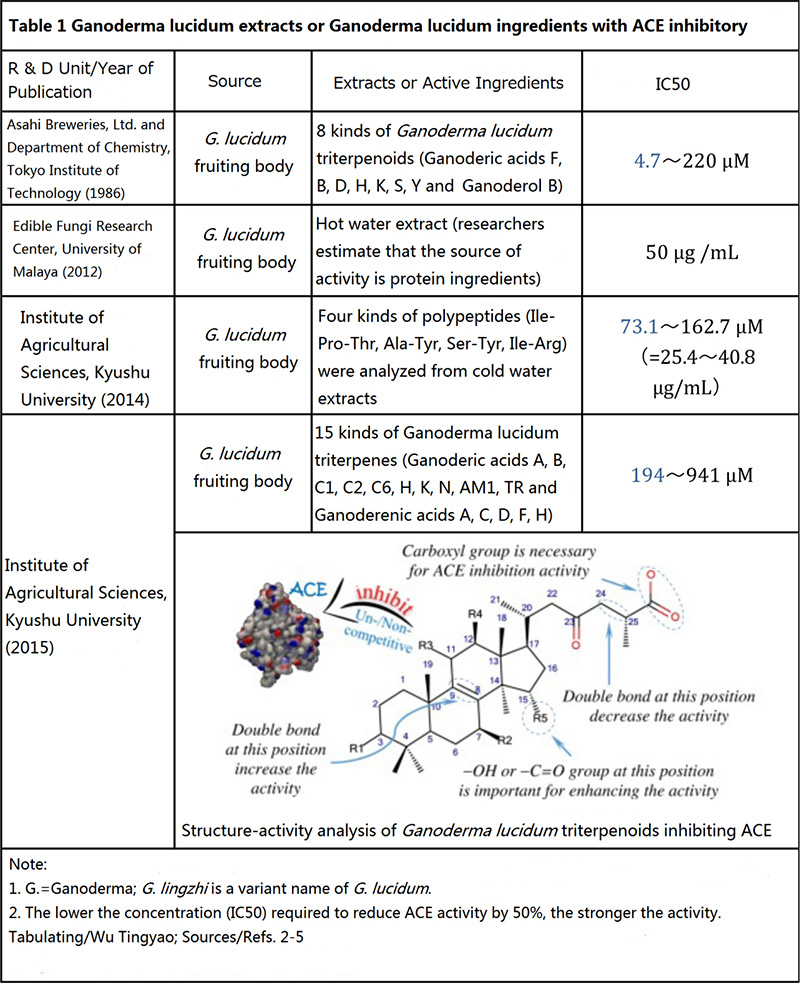
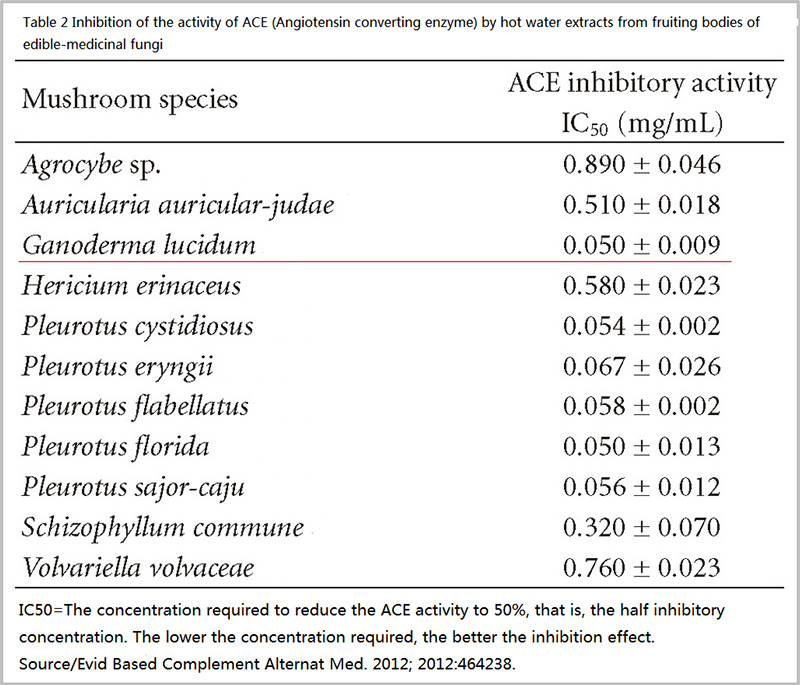
ACE 억제제의 임상 적용
ACE/ACE2 불균형 개선을위한 고려 사항
새로운 코로나 바이러스 폐렴을 치료하기 위해 ACE 억제제를 사용할지 여부는 한때 의료 커뮤니티가 망설임으로 만들었습니다..
ACE를 억제하면 ACE2의 발현이 간접적으로 증가하기 때문에. 염증과 싸우는 것은 좋은 일이지만, 산화 및 섬유증, ACE2는 새로운 코로나 바이러스의 수용체입니다. 따라서 ACE 억제가 조직을 보호하는지, 아니면 감염을 악화시키는지는 여전히 걱정스러운 문제였습니다..
요즘에는, 여러 임상 연구가 있었고 (참고자료를 참조하세요 6-9 자세한 내용은) ACE 억제제는 코로나바이러스 폐렴 환자의 상태를 악화시키지 않습니다.. 그러므로, 유럽과 미국의 많은 심장 또는 고혈압 협회에서는 불리한 임상 증상이 발생하지 않는 경우 환자에게 ACE 억제제의 사용을 계속할 것을 분명히 권장했습니다..
ACE 억제제를 사용하지 않은 코로나19 환자의 경우, 특히 고혈압이 없는 사람, 심장병 또는 당뇨병 징후, 추가 ACE 억제제를 투여해야 하는지 여부는 현재 결정적이지 않습니다. 왜냐하면 임상 연구에서 ACE 억제제 사용의 이점이 관찰되었음에도 불구하고 주로 결정적이지 않기 때문입니다. (더 높은 생존율과 같은), 의학적 지침 권고사항이 될 만큼 효과가 뚜렷하지 않은 것 같습니다..
역할영지버섯 ACE를 억제하는 것 이상입니다
ACE 억제제가 임상 관찰 기간 동안 유의미한 효과를 발휘하지 못할 수도 있다는 것은 놀라운 일이 아닙니다. (대개 1 하루에 1 월). 바이러스와 면역 체계의 싸움으로 인한 조절되지 않는 염증이 신종 코로나바이러스 폐렴 악화의 근본 원인이다. 범인이 제거되지 않았기 때문에, 물론 공범자들을 처리하기 위해 ACE를 제압하여 처음에 상황을 반전시키는 것은 어렵습니다..
문제는 ACE/ACE2 불균형이 낙타를 무너뜨리는 마지막 지푸라기가 될 가능성이 높다는 것입니다., 향후 회복에 걸림돌이 될 가능성이 높습니다.. 그러므로, 행운을 추구하고 재난을 피하는 관점에서 생각한다면, ACE 억제제를 잘 사용하면 새로운 코로나 바이러스 폐렴 환자의 회복에 도움이됩니다..
하지만, 합성 ACE 억제제로 인해 발생할 수있는 부작용과 비교, 마른 기침과 같은, allotriogeusti 및 고상한 혈액 칼륨, 이 논문을 쓴 방글라데시 학자는 자연적으로 발생하는 식용 및 약용 곰팡이에서 에이스 억제 구성 요소가 신체적 부담을 유발하지 않을 것이라고 믿었습니다.. 특히, 영지버섯, 많은 에이스 억제 성분과 비교적 우수한 억제 효과가 있습니다., 기대할만한 가치가 있습니다.
더 많은 것은 무엇입니까, 많은영지버섯 추출물 또는영지버섯 ACE를 억제하는 성분은 바이러스 복제를 억제 할 수 있습니다, 염증을 조절합니다 (사이토 카인 폭풍을 피하십시오), 면역력을 강화하다, 심혈관 시스템을 보호하십시오, 혈당을 조절하다, 혈압을 조절합니다, 혈중 지질을 조절하다, 간 손상을 줄인다, 신장 손상 감소, 폐 손상 감소, 호흡기를 보호하다, 장을 보호하다. 합성 ACE 저해 성분이나 식용 및 약용 진균 유래 기타 ACE 저해 성분은 일반 ACE 저해 성분과 비교할 수 없습니다.영지버섯 이와 관련하여.
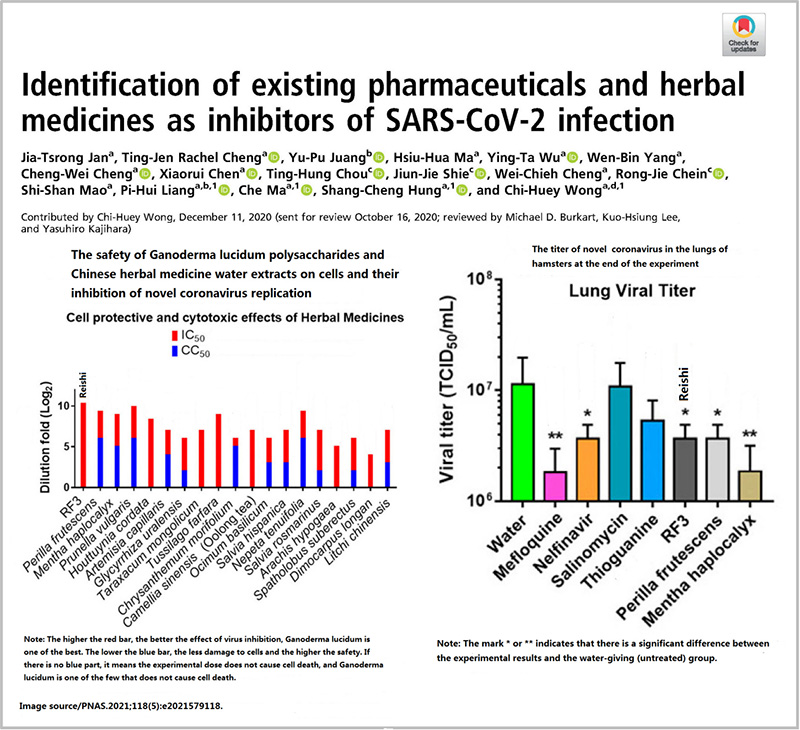
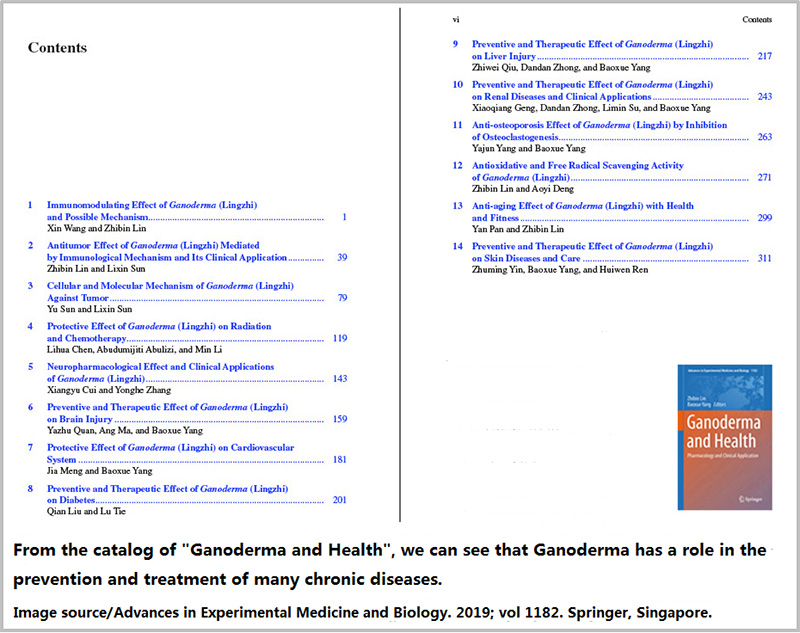
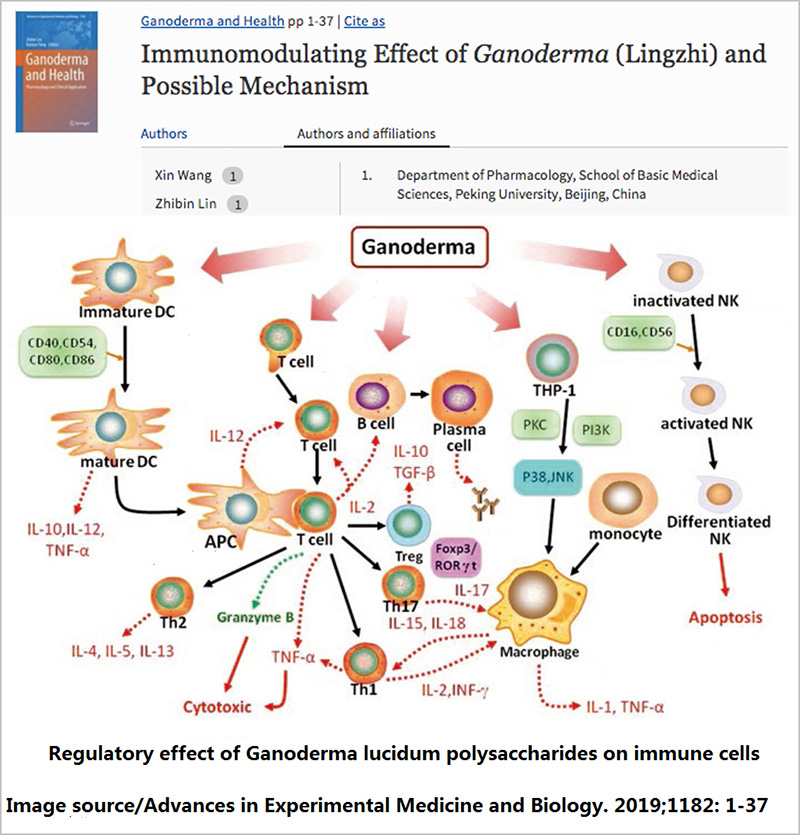
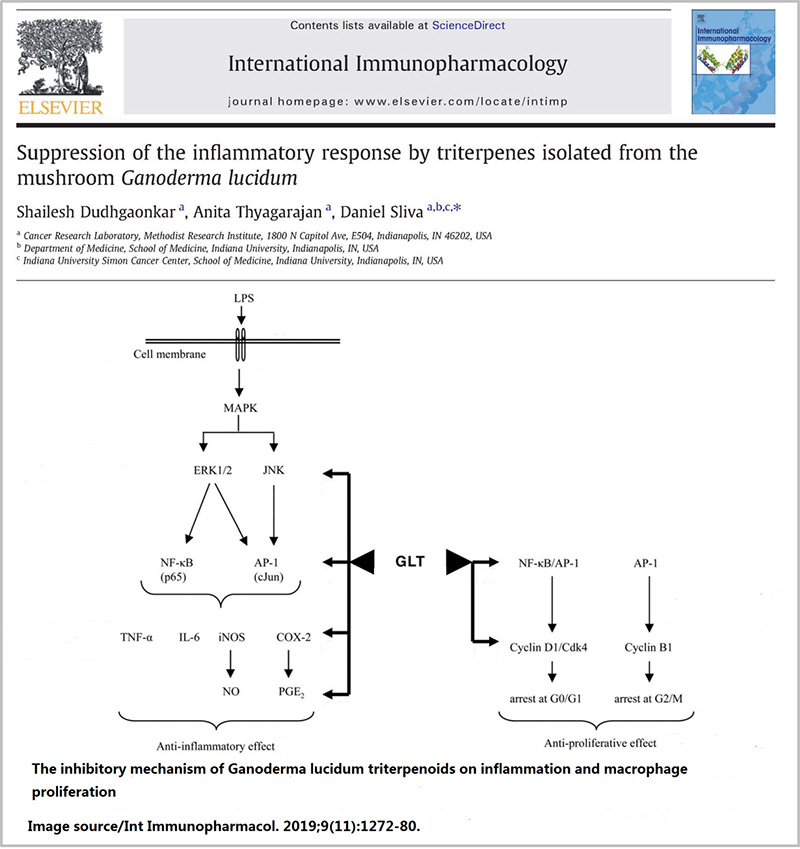
심각한 질병과 사망 위험을 줄이는 것은 위기를 완화하는 것일 뿐입니다..
신종 코로나바이러스가 ACE2를 침입 수용체로 선택한 순간부터, 치사율과 복잡성 면에서 다른 바이러스와는 다릅니다..
인체의 조직세포에는 ACE2가 너무 많기 때문에. 신종 코로나바이러스는 폐포를 손상시켜 몸 전체에 저산소증을 일으킬 수 있다, 혈액을 따라 몸에 적합한 염기를 찾으세요, 모든 곳의 면역세포를 끌어당겨 공격하게 한다, 모든 곳에서 ACE/ACE2 밸런스를 파괴하세요, 염증을 강화하다, 산화 및 섬유증, 혈압과 혈액량을 증가시킵니다., 심장과 신장에 부담을 증가, 세포 작동에 영향을 미치는 체액과 전해질 불균형을 만듭니다., 더 많은 도미노 효과를 유발합니다..
그러므로, 신종 코로나바이러스 폐렴 감염은 결코 “폐에만 영향을 미치는” “더 심각한 감기에 걸리는” 것이 아닙니다.. 신체 조직에 장기적인 후유증을 남길 수 있습니다., 장기와 생리적 기능.
코로나19 예방 및 치료를 위한 다양한 신약 개발에 대한 좋은 소식은 매우 흥미롭지만, 일부 불완전한 사실이 가까이에 있습니다:
백신 접종 (항체 유도) 감염되지 않을 것이라는 보장은 없습니다.;
항바이러스제 (바이러스 복제 억제) 질병의 완치를 보장할 수 없습니다.;
스테로이드 항염증 (면역억제) 양날의 검이다;
심각한 질병이 없어도 합병증을 피할 수는 없습니다.;
바이러스 검사가 양성에서 음성으로 바뀌었다고 해서 반드시 전염병 퇴치의 성공을 의미하는 것은 아닙니다.;
살아서 병원에서 퇴원한다고 해서 나중에 완전히 회복할 수 있다는 의미는 아닙니다..
코로나바이러스 약물과 백신이 중증 질환의 위험을 줄이는 “일반적인 방향”을 파악하는 데 도움이 되었을 때, 사망 확률 감소 및 입원 기간 단축, 우리가 스스로 처리해야 하는 "세부 사항"이 너무 많다는 것을 잊지 마세요..
인간이 지능과 경험에 의존하여 가장 좋은 효과를 달성하기 위해 특정한 영향을 미치는 다양한 정확한 구약과 신약을 결합 할 때, 우리는이 복잡한 질병을 다루기 위해 칵테일 스타일 포괄적 인 치료법을 채택하는 법을 배워야합니다..
저항 향상에서, 바이러스 복제 억제, 비정상 염증 조절, ACE/ACE2 균형 심혈관 시스템 보호, 세 가지 최고치를 조절하고 신체의 만성 질환의 부담 감소, 이것들은 Covid-19의 감염률을 줄이는 기본 요구라고 할 수 있습니다., 심각한 CovID-19를 방지하고 CovID-19의 회복을 향상시킵니다.
미래에 이러한 기본 요구를 동시에 충족시키려는 희망이 있는지는 아무도 모릅니다.. 어쩌면 머나먼 하늘에 있는 '비법 레시피'가 실제로는 바로 당신 앞에 있을지도 모릅니다.. 자비로우신 하나님께서는 오랫동안 천연 칵테일 레시피를 준비하셨습니다., 식품과 의약품의 이중 용도, 쉽게 이용 가능, 그리고 남자들에게 딱 맞는, 여성과 어린이. 그것은 단지 우리가 그것을 사용하는 방법을 아는지에 달려 있습니다..
[원천]
1. 모하마드 아지주르 라흐만, 외. Int J Med 버섯. 2021;23(5):1-11.
2. Aiko Morigiwa, 외. 켐팜불 (도쿄). 1986; 34(7): 3025-3028.
3. 누르리다 압둘라, 외. Evid 기반 보완 대체 의학. 2012;2012:464238.
4. 트란 하이방, 외. 분자. 2014; 19(9):13473-13485.
5. 트란 하이방, 외. 파이토켐 레트. 2015;12: 243-247.
6. 치라그 바비시,외. 자마 카디올. 2020;5(7):745-747.
7. 아비나브 그로버, 외. 2020 준 15 : pvaa064. 도이:10.1093/ehjcvp/pvaa064.
8. 레나토 D. 로페스, 외. 암하트J. 2020 8월;226: 49-59.
9. 레나토 D. 로페스, 외. 자마. 2021 1월 19; 325(3):254-264.
끝
저자 소개 / 씨. 우팅야오
Wu Tingyao는 이후 직접 Ganoderma lucidum 정보를 보고해 왔습니다. 1999. 그녀는 다음의 저자입니다.Ganoderma로 치유 (4월 인민의학출판사에 게재 2017).
★ 이 글은 저자의 단독 승인 하에 게재되었습니다., 소유권은 GANOHERB에 속합니다.
★ 위 작품은 복제할 수 없습니다, GanoHerb의 승인 없이 발췌되거나 다른 방법으로 사용되는 경우.
★ 이용허가를 받은 저작물인 경우, 승인 범위 내에서 사용해야 하며 출처를 표시해야 합니다.: 가노허브.
★ 위 사항을 위반한 경우, GanoHerb는 관련 법적 책임을 추구합니다.
★ 이 기사의 원문은 Wu Tingyao가 중국어로 작성하고 Alfred Liu가 영어로 번역했습니다.. 번역 내용에 차이가 있는 경우 (영어) 그리고 원본 (중국인), 원래 중국어가 우선합니다. 독자들이 궁금한 점이 있으면, 원작자에게 연락주세요, 양. 우팅야오.
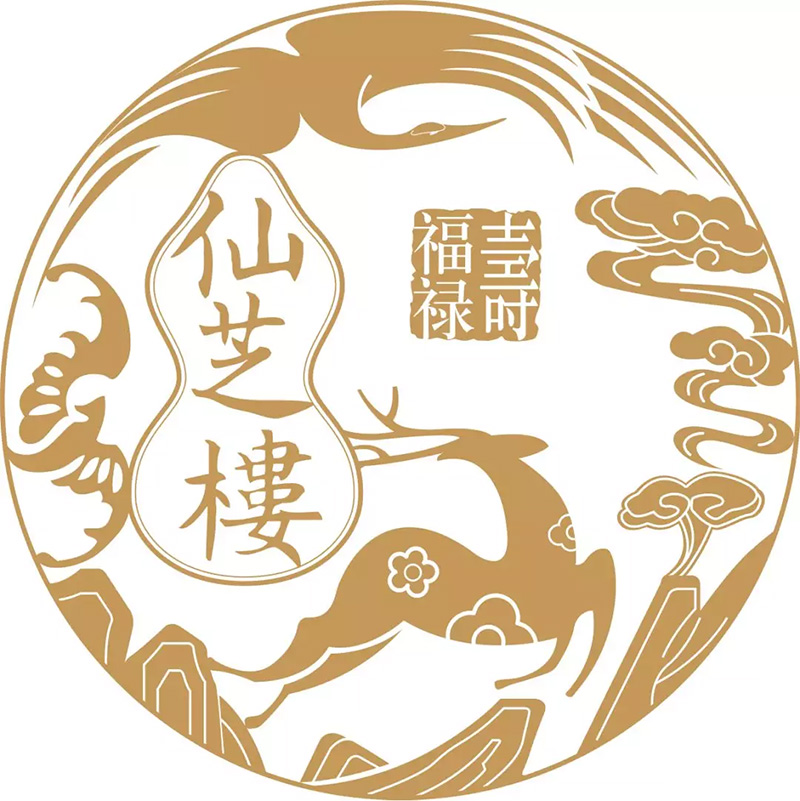
천년 건강문화를 전하다
모두를 위한 웰빙에 기여



